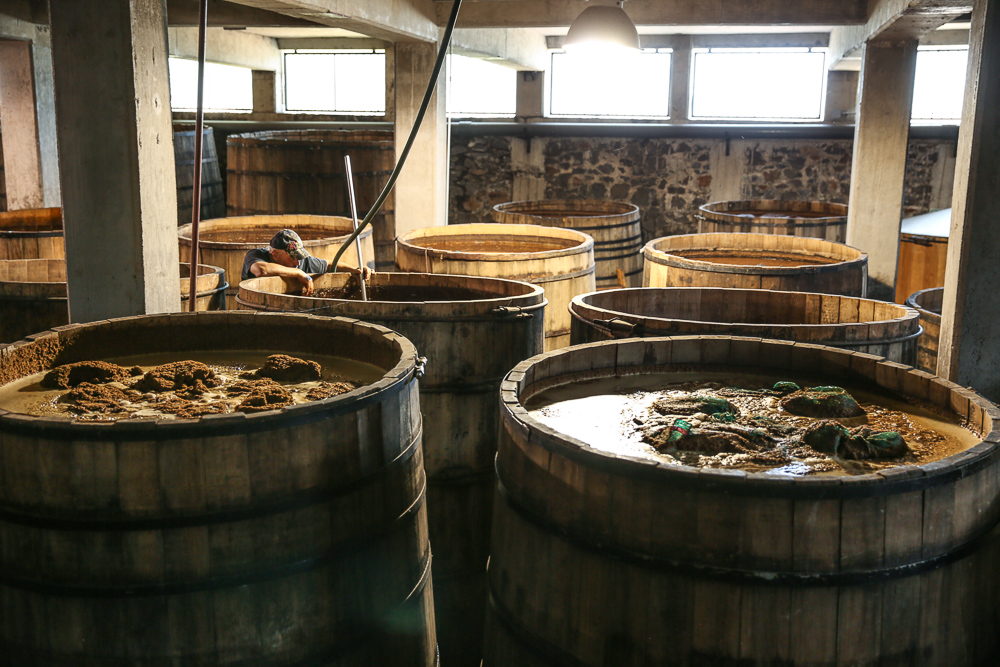Roaming the Highlands of Jalisco
There are a number of winding country roads and narrow pathways before you see the brick facade of the La Alteña distillery walls in the distance, the home of Tapatío Tequila and the facility that makes El Tesoro and Ocho as well. I'm on the hunt for new spirits in Mexico this week and Jalisco continues to be a source of serious hooch for K&L. But why am I talking about Tequila on the wine blog? I've always found that Tequila has much more in common with wine than whiskey, and in visiting the various agave distilleries of Mexico that comparison holds true on the production side as well. Some distilleries are like sterile custom crush pads with nothing more than the proper equipment and truck loads of material being dropped off for preparation. Others are actual estates, surrounded by their own vineyards (or agave fields, in this case), with an atmosphere and an aura all their own. La Alteña is definitely the latter. It's like the Ridge or Stag's Leap of Jalisco, a heralded property that has continued to make quality liquid despite its growth and enhancements over the years. Any great wine's reputation will (and should) always begin with the quality and the location of its vineyards. In the case of La Alteña, the agave is planted in the vibrant red soils of the Jalisco Highlands, which create a much different flavor profile than those planted in the Lowlands. Whereas Lowland agave produces a greener, more vegetal and herbaceous style of Tequila, Highland agave piñas tend to be larger, fruitier, and sweeter in flavor due to the difference in both soil types and climate.
While today I'm running solo out to a few other Highland distilleries, I was with great company yesterday at La Alteña. Slanted Door founder and San Francisco restaurateur Charles Phan was along with me for the ride and we talked shop on the way out to meet legendary master distiller Carlos Camarena. Carlos is a wealth of information and we spent a good hour out in the agave fields with him, learning the intricate details of agave reproduction and the delicate ecosystem that supports their growth. His father first founded La Alteña distillery in 1937, so as you can imagine there were a number of banners celebrating the 80th anniversary of the distillery around the property yesterday. Like any great winemaker, he's always been much more interested in the agricultural side of production rather than the distillation and began his career learning about agriculture.
Just like with wine, it all begins in the vineyard—or the agave field, in the case of Tequila. Fermentation is no different. Winemakers can dictate the concentration of their wine by choosing to ferment with or without the skins, while repeatedly punching down the cap that eventually forms at the top (or not) to further increase skin contact. Carlos makes the exact same stylistic decisions when fermenting his agave. Some fermentations are done with the liquid only, while others keep the agave fibers in the juice. Some are punched down so that the fibers continue to mingle with the liquid, while others are allowed to bubble up naturally. Every little variance creates a different tasting Tequila. Perhaps the most poignant story Carlos told me, however, was about water. We hear a lot about the importance of pure water sources when it comes to whisky, but not so much with the distillation of other spirits. When talking about the natural spring water that La Alteña sources for its fermentation, Carlos explained that his father and his partners actually built a second distillery in the town of Arandas back in 1938, but eventually closed it when customers complained that the Tequila tasted different than Tapatío. "The only difference was the water," Carlos said.
Due to the recent shortage of agave, many large producers (especially those using diffusers—a machine that simply strips out the starch and negates the inherent flavor) don't distinguish between the geographical origins of their piñas, but that's no different than buying a bottle of red wine that says "California" on the label and one that very specifically indicates "Howell Mountain." When you buy a bottle of El Tesoro, Tapatio, or Ocho, you know you're getting Tequila made from Camarena family estate Highland agave. In this case, buying a bottle of Camarena tequila is like buying a bottle of wine from a real domaine.
-David Driscoll




